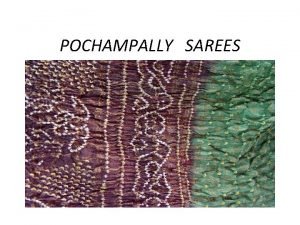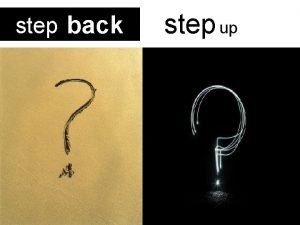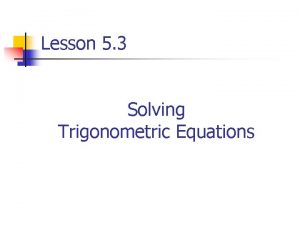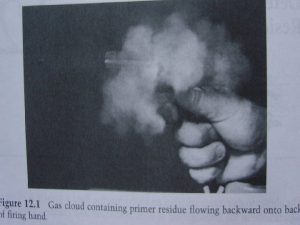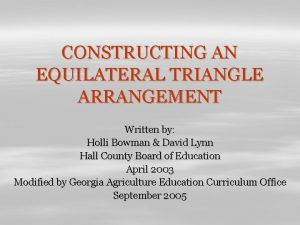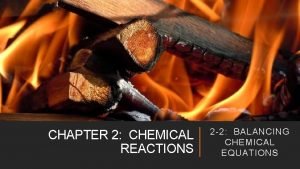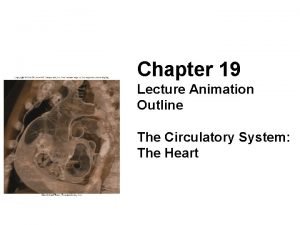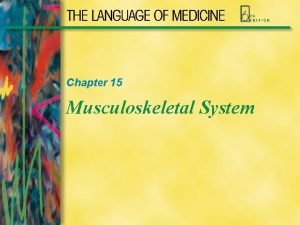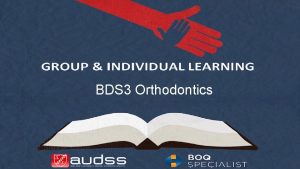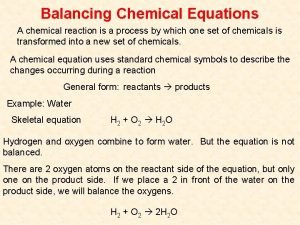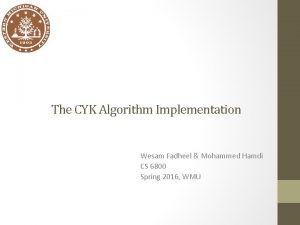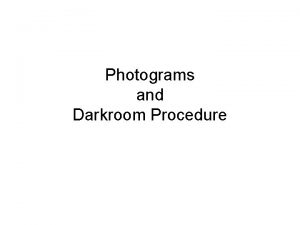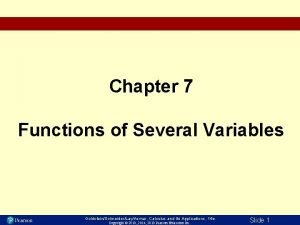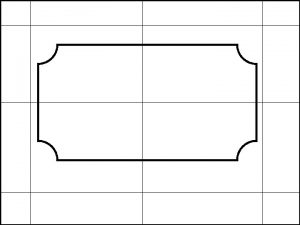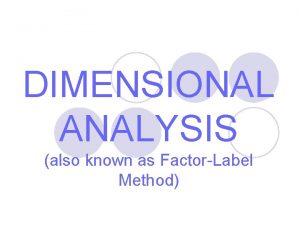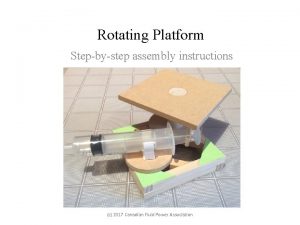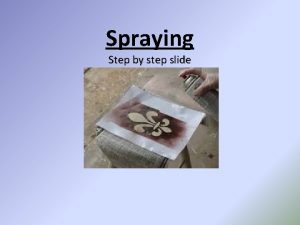First step to make your dreams come true






































































































- Slides: 102

First step to make your dreams come true is to…. . . wake up!

Pathology of Pneumonia and Lung abcess

Pneumonia Introduction: defined as n n acute inflammation of the lung parenchyma distal to the terminal bronchioles characterised by exudation and consolidation into the alveoli. 3

Pneumonia 4

Normal Lung

Pneumonia 6

Pneumonia 7

Pneumonia Pulmonary Defence Mechanism pneumonia can result whenever defense mechanisms are impaired or whenever the resistance of the host in general is lowered. lung defense mechanisms n n n as nasopharyngeal filtering action, mucociliary action of the lower respiratory airways, the presence of phagocytosing alveolar macrophages and immunoglobulins. 8

Pneumonia ETIOPATHOLOGY 9

Pneumonia Loss or suppression of the cough reflex, 1. 2. 3. 4. Coma anesthesia, neuromuscular disorders drugs, chest pain 3. Interference with the phagocytic or bactericidal action of alveolar macrophages by 1. 2. 3. 4. 2. Injury to the mucociliary apparatus 1. 2. 3. cigarette smoke, 4. hypoxia, starvation, anaemia, pulmonary oedema 5. viral respiratory infections. anoxia, oxygen intoxication Cigarette smoking, viral respiratory infections, immotile cilia syndrome inhalation of hot or corrosive gases old age 10

Pneumonia Pulmonary n n n n chronic bronchitis, bronchiectasis, fibrosis, carcinoma congestion and edema cystic fibrosis bronchial obstruction 11

Pneumonia Defect in immunity Defects in innate immunity (infections with pyogenic bacteria) n Neutrophil n complement defects humoral immunodeficiency. Leucocyte dysfunctions. n congenital and acquired immunodeficiencies (e. g. AIDS, immunosuppressive therapy) cell-mediated immune defects (congenital and acquired) increased infections with intracellular microbes mycobacteria herpesviruses microorganisms of very low virulence 12

Pneumonia Pathogenesis of Pulmonary Infections Step 1: Entry n Aspiration (ie Pneumococcus) n Inhalation (ie Mtb and viral pathogens) n Inoculation (contaminated equipment) n Colonization (in patients with COPD) n Hematogenous spread (patients with sepsis) n Direct spread (adjacent abscess) 13

Pathogenesis:

Pathogenesis:

Pneumonia: types Pneumonia is divided into six broad clinical syndromes: 1 -community acquired Acute pneumonia 2 -community acquired Atypical pneumonia 3 -hospital acquired pneumonia (Nosocomial) 4 -aspiration pneumonia 5 -Chronic pneumonia 6 -Necrotizing Pneumonia and Lung Abscess 16

Pneumonia Types: Etiologic Types: n Infective n n n Viral Bacterial Fungal Tuberculosis Non Infective n n n Toxins chemical Aspiration Morphologic types: n Lobar n Broncho n Interstitial Duration: n Acute n Chronic Clinical: n Primary / secondary. n Typical / Atypical n Community a / hospital a 17

Pneumonia INFECTIVE. n n n n A. BACTERIAL PNEUMONIA I. Lobar pneumonia II. Bronchopneumonia (Lobular pneumonia) B. VIRAL AND MYCOPLASMAL PNEUMONIA (PRIMARY ATYPICAL PNEUMONIA) C. OTHER TYPES OF PNEUMONIAS I. Pneumocystis carinii pneumonia II. Legionella pneumonia (Legionnaire’s disease) 18

Pneumonia Morphology n . fibrinosuppurative consolidation of a large portion of a lobe or of an entire lobar pneumonia Patchy consolidation of the lung is the dominant characteristic of bronchopneumonia 19

Pneumonia Lobar Pneumonia: 20

Pneumonia types of lobar pneumonia Pneumococcal pneumonia. More than 90% of all lobar 1. Streptococcus pneumoniae, lancet-shaped diplococcus. is community-acquired infection 2. Staphylococcal pneumonia by haematogenous spread of infection from another focus or after viral infections. n 21

Pneumonia Streptococcal pneumonia. β-haemolytic streptococci n as in children after measles influenza, n in severely debilitated elderly patients , diabetics. n n n 4. Pneumonia by gram-negative aerobic bacteria. Less Haemophilus influenzae, in children Klebsiella pneumonia (Friedlander’s bacillus) in aged, DM, alcoholics) n Pseudomonas, Proteus , Escherichiacoli, 22

Pneumonia Lobar Pneumonia: High fever, rusty sputum, Pleuritic chest pain. n Four stages: (*also in bronchopneumonia) n Congestion – 1 d – vasodilatation congestion. n Red Hepatization 2 d Exudation+RBC n Gray Hepatizaiton 4 d neutro & Macrophages. n Resolution – 8 d few macrophages, normal. 23

Pneumonia the early acute n congestion inflammatory response lasts for 1 to 2 days. the affected lobe is enlarged, heavy, dark red and congested. Cut surface exudes blood-stained frothy fluid i) Dilatation and congestion of the capillaries in the alveolar walls. ii) Pale eosinophilic oedema fluid in the air spaces. iii) A few red cells and neutrophils in the intraalveolar fluid. iv) Numerous bacteria in the alveolar fluid 24

Pneumonia Lobar Pneumonia: Congestion 25

Pneumonia red hepatization massive confluent exudation with neutrophils, red cells, and fibrin filling the alveolar spaces lasts for 2 to 4 days. gross examination, n the lobe red, firm, and airless, with a liver-like consistency---- hepatization cut surface of the is airless, red-pink, dry, granular n is accompanied by serofibrinous pleurisy. 26

Pneumonia Lobar Pneumonia: Red hepat. 27

Pneumonia n n i) The oedema fluid of the preceding stage is replaced by strands of fibrin ii) marked cellular exudate of neutrophils and extravasation of red cells iii) Many neutrophils show ingested bacteria. iv) The alveolar septa are less prominent than in the first stage due to cellular exudation. 28

Pneumonia n n gray hepatization disintegration of red cells and the persistence of a fibrinosuppurative exudate ----- appearance of a grayish brown, dry surface. the affected lobe is firm and heavy. The cut surface is dry, granular and grey in --------- liver like consistency. n n colour from red to grey begins at the hilum and spreads towards the periphery Fibrinous pleurisy is prominent. 29

Pneumonia Lobar Pneumonia – Gray hep… 30

Pneumonia n Histologically n fibrin strands are dense and more numerous. n macrophages begin to appear in the exudate. n The cellular exudate is separated from the septal walls by a thin clear space. The organisms are less numerous appear as degenerated forms. n 31

Pneumonia resolution n This stage begins by 8 th to 9 th day n The cut surface is grey-red or dirty brown and frothy, yellow, creamy fluid can be expressed on pressing. fibrous obliteration of pleural cavity. n the consolidated exudate within the alveolar spaces -----progressive enzymatic digestion -----granular, semifluid debris ===== resorbed. n 32

Histologically, Pneumonia n i) Macrophages are the predominant cells in the alveolar spaces contain engulfed neutrophils and debris. n n ii) Granular and fragmented strands of fibrin in the alveolar spaces iii) Alveolar capillaries are engorged. iv) progressive removal of fluid content as well as cellular exudate from the air spaces, by expectoration by lymphatics, resulting in restoration of normal lung parenchyma with aeration. 33

Pneumonia COMPLICATION n n 1. Organisation There is ingrowth of fibroblasts from the alveolar septa resulting in fibrosed, tough, airless leathery lung tissue. This type of post-pneumonic fibrosis ----- carnification. 2. Pleural effusion. develop inflammation of the pleura with effusion n 3. Empyema. pneumonia develop encysted pus in the pleural cavity termed empyema. n 4. Lung abscess. n 34

Pneumonia CLINICAL FEATURES n n n n n shaking chills fever, malaise with pleuritic chest pain, dyspnoea cough with expectoration ( mucoid, purulent bloody). tachycardia, and tachypnoea, cyanosis if the patient is severely hypoxaemic. neutrophilic leucocytosis. Blood cultures are positive in about 30% of cases Chest radiograph---- consolidation. 35

Pneumonia Lobar Pneumonia: 36

Pneumonia Acute pneumonia. The congested septal capillaries and extensive neutrophil exudation into alveoli early red hepatization. B, Early organization of intra-alveolar exudate, seen in areas to be streaming through the pores of Kohn (arrow). C, Advanced organizing pneumonia (corresponding to gray hepatization), featuring transformation of exudates to fibromyxoid masses richly infiltrated by macrophages and fibroblasts 37

Pneumonia Broncho-pneumonia n n n or lobular pneumonia is infection of the terminal bronchioles that extends into the surrounding alveoli resulting in patchy consolidation of the lung. 38

Pneumonia Broncho pneumonia 39

Pneumonia Bronchopneumonia (patchy) n n n Extremes of age. (infancy and old age) Staph, Strep, Pneumo & H. influenza Patchy consolidation – not limited to lobes. Suppurative inflammation Usually bilateral Lower lobes common due to gravitation of the secretions. 40

Pneumonia patchy consolidated lesions are dry, granular, firm, red or grey in colour, 3 to 4 cm in diameter, n often centred around a bronchiole. i) Acute bronchiolitis. ii) Suppurative exudate, consisting chiefly of neutrophils, in the peribronchiolar alveoli. n n iii) Thickening of the alveolar septa by congested capillaries and leucocytic infiltration. iv)alveoli contain oedema fluid. 41

Pneumonia Bronchopneumonia: 42

Pneumonia COMPLICATIONS. destruction of the bronchioles+foci of bronchiolar fibrosis ----bronchiectasis. CLINICAL FEATURES. q q q generally infants or elderly individuals. history of bed-ridden illness, chronic debility, aspiration of gastric contents or upper respiratory infection. Chest radiograph shows mottled, focal opacities in both the lungs, in the lower zones. 43

Pneumonia Broncho Pneumonia 44

Pneumonia Bronchopneumonia - CT 45

Pneumonia Bronchopneumonia 46

Pneumonia Broncho – Pneumonia - Lobar n n n n Extremes of age. n Secondary. n Both genders. n Staph, Strep, H. infl. n Patchy consolidation n Around Small airway n n Not limited by anatomic boundaries. n Usually bilateral. Middle age – 20 -50 Primary in a healthy males common. 95% pneumoc (Klebs. ) Entire lobe consolidation Diffuse Limited by anatomic boundaries. Usually unilateral 47

Broncho – Pneumonia - Lobar

Pneumonia Pathogenesis of Clinical features: *Alveolar inflammation. n Tachypnoea, Dyspnoea, Resp Acidosis Solid/airless lungs – decreased oxygenation. n Dull percussion - Consolidation – Exudation n Rusty sputum - RBC & Inflammatory cells. n Fever – Inflammatory mediators. 49

Pneumonia Complications of Pneumonia n Abscesses n n n Pleuritis / Pleural effusion. n n n Inflammation of the pleura ( Streptococcus pneumoniae) Blood rich exudate (esp. rickettsial diseases) Empyema n n Localized suppurative necrosis, Right side often in aspiration. Staphylococcus; Klebsiella; Pneudomonas Pus in the pleural space. Septicemia 50

Pneumonia Abscess formation 51

Pneumonia n Community acquired atypical pneumonia 52

Pneumonia VIRAL AND MYCOPLASMAL PNEUMONIA patchy inflammatory changes, largely confined to interstitial tissue of the lungs, without any alveolar exudate. • Other terms interstitial pneumonitis, interstitial location of the inflammation, primary atypical pneumonia, atypicality ----being the absence of alveolar exudate commonly present in other pneumonias. • mild and transient severe in • malnutrition • chronic debilitating diseases • alcoholism. 53

Pneumonia MORPHOLOGIC FEATURES. Grossly, patchy to massive and widespread consolidation of one or both the lungs. • The lungs are heavy, congested and subcrepitant. • Sectioned surface of the lung exudes small amount of frothy or bloody fluid. hallmark of viral pneumonias is the interstitial nature of the inflammatory reaction. 54

Pneumonia Interstitial Pneumonia: 55

Pneumonia Interstitial Pneumonia: Lymphocyte Infiltrate in alveloar wall 56

Pneumonia i) Interstitial inflammation: ii) There is thickening of alveolar walls due to congestion, oedema and mononuclear inflammatory infiltrate ii) Necrotising bronchiolitis: necrosis of the bronchiolar epithelium, üsecretions in the lumina ü mononuclear infiltrate in the walls and lumina. iii) Reactive changes: The lining epithelial cells of the bronchioles and alveoli proliferate ü multinucleate giant cells and syncytia in the bronchiolar and alveolar walls. ü Occasionally, viral inclusions (intranuclear and/or intracytoplasmic) in CMV. 57

Pneumonia iv) Alveolar changes: üthe alveolar lumina may contain oedema fluid, fibrin, scanty inflammatory exudate ü coating of alveolar walls by pink, hyaline membrane 58

Pneumonia ETIOLOGY. respiratory syncytialvirus (RSV). Mycoplasma pneumoniae influenza and parainfluenza viruses, adenoviruses, rhinoviruses, coxsackieviruses cytomegaloviruses 59

Pneumonia COMPLICATIONS. The major complication superimposed bacterial infection interstitial fibrosis and permanent damage. 60

Pneumonia CLINICAL FEATURES . fever, headache and muscle-aches A dry, hacking, non-productive cough with retrosternal burning due to tracheitis and bronchitis. Lab finding neutrophilic leucocytosis. Chest radiograph show patchy or diffuse consolidation. Cold agglutinin titres in the serum are elevated in (almost half the cases of mycoplasmal pneumonia, adenovirus ) 61

Pneumonia aspiration pneumonia results from inhalation of different agents into the lungs. ie: food, gastric contents, foreign body , infected material from oral cavity factors predispose : unconsciousness, drunkenness, n neurological disorders affecting swallowing n drowning, n necrotic oropharyngeal tumours, n in premature infants n congenital tracheo-oesophageal fistula. n Aspiration of sterile foreign matter (acidic gastric contents) produce chemical pneumonitis 62 n

Pneumonia MORPHOLOGIC FEATURES. characterised by n haemorrhagic pulmonary oedema n presence of particles in the bronchioles. CLINICALY n cyanosis n dyspnoea, n Shock bloody sputum Later: n secondary bacterial infection Die of cardiac failure. 63

Pneumonia n n n 2. Non-sterile aspirate causes widespread bronchopneumonia with multiple areas of necrosis and suppuration. A granulomatous reaction with foreign body giant cells may surround the aspirated vegetable matter. 64

Pneumonia Lipid Pneumonia 2 types: exogenous endogenous. n 1. Exogenous lipid pneumonia. n aspiration of oily materials. n inhalation of oily nasal drops, n regurgitation of oily medicines from stomach (e. g. liquid paraffin), n administration of oily vitamin preparation n to reluctant children or to debilitated old patients. 65

Pneumonia 2. Endogenous lipid pneumonia n The sources of origin are tissue breakdown following n obstruction to airways bronchogenic cancer, tuberculosis and bronchiectasis. n 66

Pneumonia MORPHOLOGIC FEATURES. Grossly exogenous lipid pneumonia n n n affects the right lung more frequently, The affected part of the lungs is consolidated. Cut surface is characteristically ‘golden yellow’. Microscopically i) Lipid is finely dispersed in the cytoplasm of foamy macrophages within the alveolar spaces. n ii) formation of cholesterol cleft. n iii) Formation of granulomas with foreign body giant cell around the large lipid droplets. n 67

Pneumonia CHRONIC PNEUMONIA n n Chronic pneumonia is most often a localized lesion in the immunocompetent patient, with or without regional lymph node involvement. the inflammatory reaction is granulomatous, and is caused by bacteria (e. g M. tuberculosis) or fungi (e. g. Histoplasma capsulatum). 68

Pneumonia Comm – Pneumonia - Nosoc n n 1. n n In healthy adults n 1. Gram positive. 2. Streptococcus 3. pneumoniae (90%) n Strep. Pyogenes, n Staph, n H. influenzae Klebsiella in elderly n , COPD. Bacteria common to the hospital environment may have acquired resistance to antibiotics invasive procedures, intubations and injections, are common; bacteria may contaminate equipment used in respiratory care units. In *sick patients. gram-negative bacilli Pseudomonas aeruginosa, Escherichia coli, Enterobacter, Proteus, and Klebsiella 69

Pneumonia 70

Pneumonia LUNG ABSCESSES Definition: Necrosis of the pulmonary tissue & formation of cavities containing necrotic debris or fluid caused by microbial infection. The formation of multiple small (< 2 cm) abscesses referred as necrotizing pneumonia or lung gangrene 71

Pneumonia Lung abscesses can be classified based on the duration Acute abscesses----- less than 4 -6 wks old, chronic abscesses ------ longer duration. On etiology Primary abscess is infectious in origin, caused by aspiration or pneumonia in the healthy host. 72

7 Pneumonia 3 Secondary Abscess - Pre-existing condition (obstruction). Spread from an extra-pulmonary site. Bronchiectasis. An immuno-compromised state. Classification On responsible pathogen, Staphylococcus lung abscess anaerobic Aspergillus lung abscess. 73

7 Pneumonia 4 Mode of spread of The bacterial infection that most common is aspiration of oro-pharyngeal contents. 74

Pneumonia Factors contributing to lung abscess 1. Oral cavity disease Periodontal disease Gingivitis 2. Altered consciousness[ an absent gag reflex] Alcoholism Coma Drug abuse Anesthesia Seizures 75

Pneumonia 3. Immunocompromised host Steroid chemotherapy Malnutrition Multiple trauma 4. Esophageal disease Achalasia Reflux disease Depressed cough and gag reflex Esophageal obstruction 76

Pneumonia 5. Bronchial obstruction Tumor Foreign body Stricture Generalized sepsis 6. patients with lung disorders Septic emboli from tricuspid endocarditis. Vasculitis disorders. Cavitating lung malignancies. Pulmonary cystic diseases. 77

Pneumonia Pathophysiology Lung abscess arises as a complication of aspiration pneumonia caused by mouth anaerobes. A bacterial inoculums from the gingival crevice reaches the lower airways, infection is initiated coz the bacteria aren’t cleared by the patient’s host defense mechanism. 78

Pneumonia Abscesses generally develop in the right lung and involve the posterior segment of the right upper lobe, This is due to gravitation of the infectious material from the oropharynx into these dependent areas. 79

. the aspirated material settles in the distal bronchial system a localized pneumonitis + Pneumonia Within 24 -48 hours, a large area of inflammation results consisting of exudate, blood, and necrotic lung tissue. abscess frequently connects with a bronchus 80

Microbiology anaerobes & aerobes. The most common anaerobes are Peptosretococcus, Bacteroids, Fusobacterium species Microaerophilic streptococcus. 81

82 Non-bacterial pathogens may also cause lung abscesses Theses micro-organisms include: 1) Parasites [Paragonimus , Entamoeba]. 2) Fungi [Aspergillus , Cryptococcus , Histoplasma , Blastomyces , Coccidioides]. 3) Mycobacterium.

History fever cough with sputum production foul smelling & bad tasting night sweats anorexia & weight loss Patients may develop hemoptysis or pleurisy 83

Physical evidence of gingival disease is present. Clinical findings of consolidation may be present [decreased breath sounds, dullness to percussion, bronchial breath sounds, course inspiratory crackles]. 84

85 signs of pleural effusion, empyema & pyo-pneumothorax [dullness to percussion, contralateral mediastinal shifting & absent breath sounds over the effusion]. Digital clubbing may develop rapidly.

Differential Diagnosis 1) Alcoholism 2) Pleuro-pulmonary 7) Pneumocystis Carnii pneumonia. 8) Aspiration pneumonia. Empyema. 9) Bacterial pneumonia. 3) Hydatid Cysts. 10) Fungal pneumonia. 4) Lung Cancer. 11) Pulmonary embolism. 5) Mycobacterium. 12) Sarcoidosis. 6) Pneumococcal infections. 13) T. B. 86

Lab Studies - CBC - Sputum for gram stain, culture & sensitivity - If T. B. is suspected, acid fast bacilli stain & mycobacterial culture - Blood culture - sputum for ova & parasite 87

Lung Abscess: The pleura is thickened. lung shows multiple cavities 1 -4 cm in diameter having irregular andragged inner walls (arrow). §The lumina contain necrotic debris §septic or pyaemic abscesses are multiple and scattered through out the lung,

Histopathology A thick-walled lung abscess 89

Lung Fungal Abscess: Candida

MORPHOLOGIC FEATURES. 91 § Abscesses due to aspiration are more likely to be in right lung § frequently single. § They are commonly located in the lower part of the right upper lobe or apex of right lower lobe.

Microscopy 92 destruction of lung parenchyma with suppurative exudate in the lung cavity. The cavity is surrounded by acute inflammation in the wall replacement by chronic inflammatory cell infiltrate chronic cases, § ----fibroblastic proliferation forming a fibrocollagenic wall

Lung Abscess:

Pneumonia Abscess formation 94

Pneumonia Histology of lung abscess shows dense inflammatory reaction (low power) 95

Pneumonia Histology of lung abscess shows dense inflammatory reaction (high power) 96

Pneumonia - The wall thickness of a lung abscess progresses from ill-defined to wellcircumscribed as the surrounding lung infection resolves. - The cavity wall can be smooth or ragged but is less commonly nodular, which raises the possibility of cavitating carcinoma. 97

Pneumonia Complications 1) Rupture into pleural space causing empyema. 2) Pleural fibrosis. 3) Trapped lung. 4) Respiratory failure. 5) Bronchopleural fistula. 6)Pleural cutaneous fistula. . 98

Pneumonia Pneumococcal pneumonia complicated by lung necrosis & abscess formation 99

Pneumonia Important questions Q. 1 -Enumerate the various pulmonary infections n Q 2 -Enumerate the complications of acute bacterial pneumonia. n Q 3 - Write briefly on communityacquired acute viral pneumonia. n Q. 4 - Outline the aetiopathogenesis, morphology and complications of lung abscess. n 100

Pneumonia n n Q 5 - DIFFERENTIATE BETWEEN LOBAR AND BRONCHOPNEUMONIA Q 6 -DESCRIBE VARIOUS MORPHOLOGICAL STAGES OF PNEUMONIA 101

The only place where success comes before work is in a dictionary…! Vidal Sassoon
 Step 1 step 2 step 3 step 4
Step 1 step 2 step 3 step 4 María xosé silvar dreams come true
María xosé silvar dreams come true I hope you know somebody loves you
I hope you know somebody loves you Steps of making wudu
Steps of making wudu Pochampally sarees history
Pochampally sarees history Come rico, come sano
Come rico, come sano Get in touch with god turn your radio on
Get in touch with god turn your radio on First come first serve
First come first serve First come first serve gantt chart
First come first serve gantt chart Hold fast to your dreams for without them life is a broken
Hold fast to your dreams for without them life is a broken Randy pausch childhood dreams
Randy pausch childhood dreams Your kingdom come your will be done
Your kingdom come your will be done True or false true or false
True or false true or false Chapter 2 jesus christ true god and true man
Chapter 2 jesus christ true god and true man Similarities between domestic and international hrm
Similarities between domestic and international hrm Late mesial shift
Late mesial shift Dino the dinosaur text structure
Dino the dinosaur text structure How to write an informative essay step by step
How to write an informative essay step by step Persuasive essay sentence starters
Persuasive essay sentence starters Step up step back
Step up step back Solve
Solve Linear equation solver with steps
Linear equation solver with steps Simultaneous equations step by step
Simultaneous equations step by step How to combine like terms step by step
How to combine like terms step by step Steps in photosynthesis
Steps in photosynthesis Bayes filter matlab
Bayes filter matlab Oracle real application testing step by step
Oracle real application testing step by step Netbackup bare metal restore step by step
Netbackup bare metal restore step by step 5-3 practice solving trigonometric equations
5-3 practice solving trigonometric equations Naomi campbell face shape
Naomi campbell face shape Punnett square step by step
Punnett square step by step Viva video collage
Viva video collage Fusioncompute cluster
Fusioncompute cluster Graph of sine and cosine functions
Graph of sine and cosine functions How do you divide decimals step by step
How do you divide decimals step by step Dermal nitrate test procedure
Dermal nitrate test procedure Isosceles triangle flower arrangement
Isosceles triangle flower arrangement Completing the square purpose
Completing the square purpose Perfect square trinomial
Perfect square trinomial How to balance chemical equations step by step
How to balance chemical equations step by step Step-by step inventory process
Step-by step inventory process Is it balanced
Is it balanced Blood flow through the heart step by step
Blood flow through the heart step by step Knuckle like process at the end of a bone
Knuckle like process at the end of a bone Incisal labiality
Incisal labiality How are stars formed step by step?
How are stars formed step by step? Hook introduction examples
Hook introduction examples Stage 1: denial
Stage 1: denial How to solve two step inequalities
How to solve two step inequalities Explain how something works
Explain how something works Steps in dishwashing
Steps in dishwashing How to balance an equation step by step
How to balance an equation step by step How to create inbound proxy in sap abap
How to create inbound proxy in sap abap Example of quadratic inequality
Example of quadratic inequality Piecewise function problem solving examples with answers
Piecewise function problem solving examples with answers Karim hamdi
Karim hamdi The 8-step method
The 8-step method Step-by-step examples
Step-by-step examples Caiet de evaluare step by step
Caiet de evaluare step by step Examples of two step inequalities
Examples of two step inequalities Visual studio disassembly
Visual studio disassembly What is a photogram?
What is a photogram? Lagrange multiplier calculator step by step
Lagrange multiplier calculator step by step Caiet de evaluare step by step
Caiet de evaluare step by step Church planting steps
Church planting steps Bronchoscopy step by step
Bronchoscopy step by step Life cycle of a star video
Life cycle of a star video How to solve trigonometric equations step by step
How to solve trigonometric equations step by step Factor by completing the square
Factor by completing the square Project portfolio management process steps
Project portfolio management process steps How to solve piecewise functions step by step
How to solve piecewise functions step by step Computer assembly step by step
Computer assembly step by step Draw compass rose
Draw compass rose How to write a limerick
How to write a limerick Easy isometric drawing exercises
Easy isometric drawing exercises Step costs
Step costs Factor label method steps
Factor label method steps Photoepilation milady
Photoepilation milady How to write a persuasive essay step by step
How to write a persuasive essay step by step Jamie tried to solve an equation step by step.
Jamie tried to solve an equation step by step. Oracle zero downtime migration
Oracle zero downtime migration Step-by-step assembly instructions
Step-by-step assembly instructions Netscape 10
Netscape 10 Nacac step by step
Nacac step by step Exponential inequality definition
Exponential inequality definition Step-by-step assembly instructions
Step-by-step assembly instructions Oracle real application testing step by step
Oracle real application testing step by step Describe the process of preparing apple juice in 5 steps
Describe the process of preparing apple juice in 5 steps Step up step back
Step up step back Fabric process step by step
Fabric process step by step How to draw a water tower step by step
How to draw a water tower step by step Wpf step by step
Wpf step by step Vmware capacity planner
Vmware capacity planner Step by step tools
Step by step tools Step 1 in 7 step improvement process
Step 1 in 7 step improvement process How to perform an exorcism step by step
How to perform an exorcism step by step Prophecies about to come true
Prophecies about to come true Prefix believe
Prefix believe Fill in the blank to make the statement true
Fill in the blank to make the statement true Come holy ghost lyrics
Come holy ghost lyrics Hey come on out setting
Hey come on out setting Come thou fount come thou king lyrics
Come thou fount come thou king lyrics Past and past participle of fall
Past and past participle of fall




